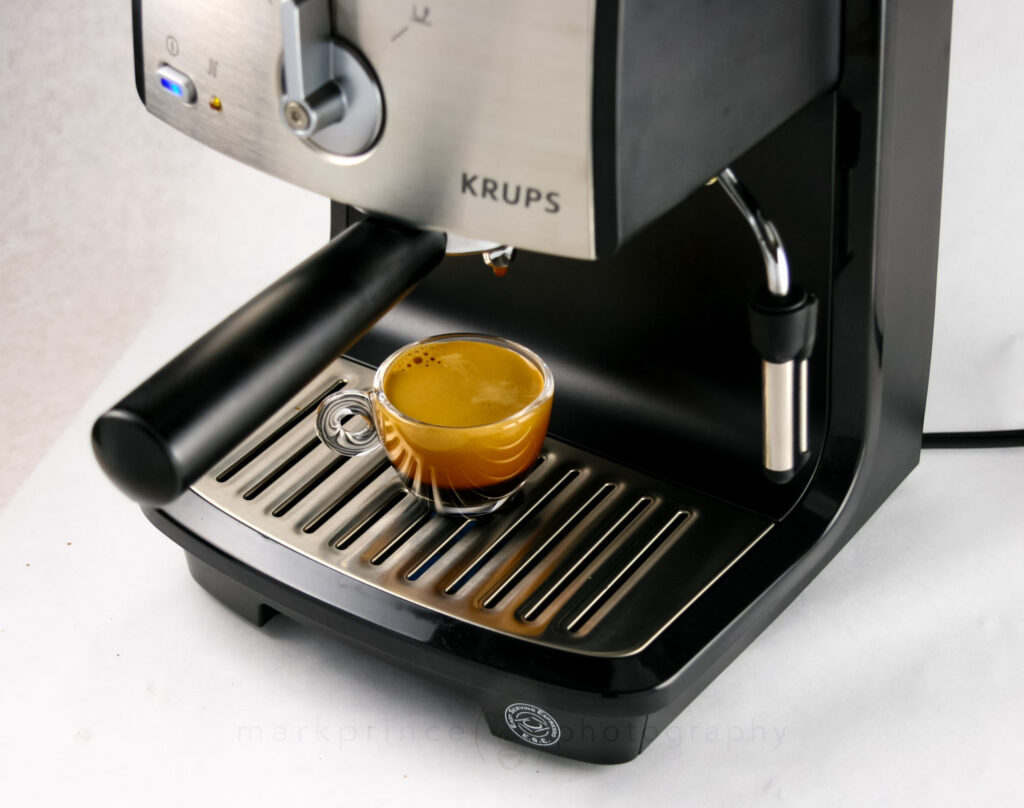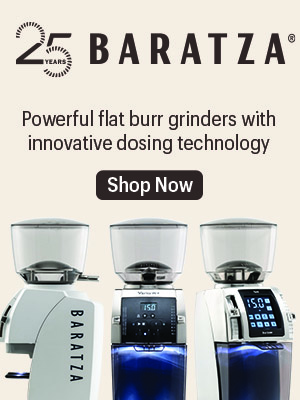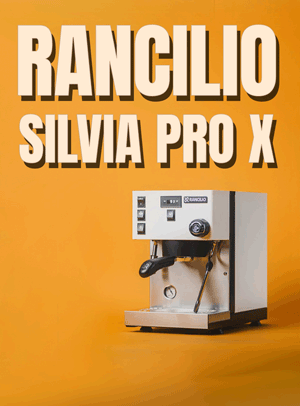In my last article for CoffeeGeek, I talked about two categories you could do to improve your home coffee game: having better water, and using scales. Water — especially — can drastically improve your coffee quality, depending on where you live and what your tap water quality is like. The scales? They help you with being consistent, help you with being precise and following roaster recommendations for brewing ratios, and they help you troubleshoot as you continually improve your home coffee making skills.
This article is going to talk about additional ways you can improve your home coffee game, including what I think is the biggest single improvement you can do. But first…
For When You Buy Roasted Coffee
Most of us don’t “home roast” our coffees (though you should consider doing it, it’s fun, rewarding, and really opens up your ability to try a wide variety of the world’s specialty coffees!), and we rely on buying coffee from companies we think are good, specialty coffee roasters and retailers. But how can you actually know the coffee roaster is good, besides hearing the unbiased opinions of others? Well, there’s a few quick clues I can share with you, ones you can make use of before you even taste a cup, but my first tip is just that: taste the coffee! As an aside, when you see me mention “roasters” or “roasteries” in this article, I’m also talking about cafes (who don’t roast their own coffee), and roaster / retailers.
Public Coffee Tastings
Some of the best specialty roasters will feature weekly or monthly “tastings” of their seasonal coffee offerings, some times even at no cost; if you find a cafe in your town that does this kind of thing, definitely take advantage of it. It’s also a sign that the roastery takes quality serious, and they are enthusiastic about sharing this quality with their customer base. In fact, many of the best and most quality driven roasters out there see their business with you, the enlightened customer, as a relationship worth developing and building; if you find a roaster in your local town that has this kind of mentality, things are really good for you. If you don’t, first, keep looking, but second, consider sourcing mail order coffees from roasters who mail it the day they roast (more on that below).

If your local cafe / roastery doesn’t have public tastings, you can still shell out a few bucks to individually taste all the coffees they serve. Look for cafes that have a variety of coffees available via manual pourover, or press pot methods: if the cafe just has one coffee available day in, day out (usually called “our signature blend” or “XYZ country!” with zero information), avoid them. If you walk into a shop that has a short list by the cash till, listing 2, 3, or more coffees available on order for drinking, including tasting notes, that’s a very good sign. If this cafe rotates their coffee “offerings” on a weekly or monthly basis, that’s even better.
Once you’ve found a cafe like this, drink the coffees! Try the entire sheet of daily offerings! Some cafes may even offer you a “sampler” taste (a small espresso sized cup of the coffee) for free, so don’t be shy about asking. Once you taste all the offerings, see if there’s a coffee (or two, or more) you like. If you do, you’ve found a possible source for buying your coffees, whole bean, for home use.
Roasted On Dates
A very positive sign when you look at bags of coffee in a roastery or cafe is this: a very clear “roasted on: date. Not “best by” or “Use by”, and not obscured in microscopic print on the bottom of the bag, but clearly on the main label or front or back of the bag. Second, if you find a “roasted on” date on the bag, but it was more than 3 or 4 weeks ago, that’s not a good sign. Walk away from that coffee. It doesn’t necessarily mean that cafe’s offerings are all crap, but no self-respecting specialty roastery would have a coffee on the shelf that’s more than 3 or 4 weeks old.
If the cafe has “Best By” or “Use by” dates on the bag, or worse, “Good for 6 months” or some shit like that, walk out of the cafe. Do not buy their coffee.

Absolutely demand that your coffee supplier not only has roasted on dates right on their bags of coffee, but they’re within a few weeks of your purchase date
A Few Minor Tips
If the cafe or roastery you visit is heavy on the espresso, look and listen to see if they’re grinding fresh for each and every shot. If they are, they take their coffee a bit more seriously than cafes that fill their espresso dosers with a half pound of pre-ground coffee. Also, look for cafes that only (and I mean only) have their coffees in bags; if the coffees are in big bins and they scoop out some when you order a bag, this has two negatives: first, all that coffee’s exposed to oxygen for days on end, making it stale. Second, chances are there’s some really old skanky coffee in there from a month or two ago, mixed in with the fresher stuff. Coffee in bags, with one way air valves are the sign of quality and freshness.
Mail Order Coffees
Sometimes, your city or town just doesn’t have a good roaster or cafe within convenient distance. Fortunately, some of the best roasters in North America all do mail order service. While I won’t recommend any in this article in interest of fairness, I do have some tips on how to avoid bad choices. I’ll do them in bullet form.
- Only buy from companies that mail their coffees on their roast date, or within a day of roasting. Most will state this on their online websites, or in their marketing literature. If you cannot find this information, ask, and if you get any other answer than “yes, we ship the day we roast, or within 24 hours of roasting”, then start looking for another online vendor. There’s many sweet talkers out there who will tell you “our coffee is great for weeks and weeks, so don’t worry!”. Yes, you should worry.
- Avoid “concierge” type coffee mail order services entirely. There’s many out there: companies that will claim (more on that below) to scour the country far and wide to find the best coffees, and sell you subscriptions of these coffees, delivering you 2, 4, or more different roasters’ coffees each month. First, many are kind of scammy, working with a very limited numbers of desperate roasters (and usually they get the coffees from the roasters for free, while charging you a fortune). Second, the coffees are old and kind of stale by the time they get to you because they have to go through 2 shipments – from roaster to reseller, from reseller to you. Third, it’s prohibitively expensive, sometimes costing as much as $30 or more a pound (they only ship you 3, 4, 6oz in most scenarios, making it harder to figure out the per lb price). And last, coffee’s already kind of carbon-unfriendly, with its growing conditions and transport from the Tropics to the importer, from the importer to the roaster, from the roaster to the cafe (or to you by mail order). This adds another level of carbon to it all, going from roaster to reseller, and reseller to you. As a final caveat, there are perhaps a few “good” coffee concierge services out there, but I just recommend staying away, or if you must use them, use them as a one-time thing to try and find some good mail order roasters.
- Look for full transparency in your mail order coffee company. What’s full transparency: detailed cupping notes, information on origin (ie, where the coffee came from), and companies that are honest about their coffees (ie… “we love this as drip coffee, but some may find it a bit weak for espresso”. After reading through a few websites, you’ll get the sense who are more transparent, and who are not. “Our secret premier blend is a nine generation recipe of 8 different coffees!” is not transparent, at all. In specialty coffee, transparency = better coffee.
That’s my tips for buying whole bean roasted coffees. Now I want to take you into the best possible tip I have for you if you want to up your home coffee game. First, I want to tell a story.
A Revelation about Espresso

When I first heard about the CoffeeGeek website and it’s owner, it was from a big full page article that appeared in the Montreal Gazette about him and his love for coffee. He said something in the article that I always remembered: “I can make better coffee with a $250 espresso machine and a $500 grinder than I can with a $5,000 espresso machine and a $50 grinder”.
I didn’t quite believe it at the time, but I always remembered that quote. Turns out… it’s true.
Like most espresso and coffee nerds, I was entirely fascinated with “the machine”. The espresso machine. I remember getting my Silvia and thinking that’s it, I’ll have literally the best espresso ever! Problem was, I thought I could make do with a Capresso mill grinder I had for a year or two by that point. Well guess what. The espresso was pitiful. It always ran too fast no matter how much coffee I put in the basket or how “fine” I tried to grind it with the Capresso. I even tried to grind the coffee twice (a tip: do not try this). That was a disaster. I ended up getting my local cafe to grind coffee in their shop espresso grinders for me (against their better wishes), and believe it or not, that was an improvement of sorts – at least the espresso brewed at the right speed of extraction! But there was little to no crema on my shots.
A year later (2009), I was living in Vancouver, and I heard about Mark Prince (the owner of this site) and a new “CoffeeGeek Lab” he had opened up in of all places, a garage. I went to visit, and just fell in love with that little mad scientist cave. Everywhere I turned, there was coffee and espresso equipment. There were something like 20 machines up and running, powered on, ready to pull shots and brew coffee. I managed to talk to him about my trials at home trying to make a good cup of espresso, and confessed to the Capresso mill grinder and getting my coffee preground, and almost giving up on good espresso. He said “aha, I have something to show you”. He went to a mini fridge and pulled out a tupperware container. “I have some coffee I ground this morning, and I’ll pull you a shot with it, then pull a shot with the same grinder, but using fresh ground”. He did, and the difference was nothing short of spectacular: the fresh ground shot was one of the best quality shots of espresso I had ever tasted.

But he wasn’t done. “See that machine over there?” pointing at some cheap looking department store (ed.note: Krups) espresso machine on the side. “Lets pull a few shots on that”. He did some changes to the main espresso grinder he was using (ed.note: it was a Compak K10 Konic WBC model), pulled out a scale, and ground out a set amount. Went to the (Krups) espresso machine, set up the shot and pulled it. He didn’t like what he saw, so he made some adjustments to his grind and dose and tried again. Again, didn’t like the taste, but this time he ran some water through the cheap machine (“temperature surfing”, he said) but otherwise used the same settings, dose and grind as the previous shot pull. This one he liked. Then he pulled one for me. It wasn’t as tasty as the one he pulled on his Lab Linea, but it was a pretty great shot of espresso, from a $200 espresso machine.
He still wasn’t done. “You see what that machine is capable of, right?”. Then he pulled down cheap-looking grinder (ed.note: it was a Bodum Bistro grinder) and set it to the finest settings, ground out a dose, and tried pulling a shot on the (Krups Espresso Machine). It was gushing everywhere. We didn’t drink it. Then he repeated using the cheap grinder and ground out a dose for his main Lab espresso machine. Again it was a gushing, sad looking shot. I tasted it and it was memorably horrible.
This was the quote I remembered in the newspaper, personified. And I became a full on “quality grinder” convert that day. I bought a Baratza Virtuoso that week, and within a year, bought a Compak K3 Doser based on Mr. Prince’s recommendation. (today, I use a Baratza Sette 270W and love it).
Up Your Home Coffee Game with a Better Grinder!
So that’s my story, but how about some facts to back it up, based on all my research and reading done the past 8 years after tasting those great coffees at that garage lab.
Coffee’s Mortal Enemy
You know what coffee really hates? It hates oxygen. Oxygen kills ground coffee. So coffee has a protectionism mechanism against oxygen: its whole-bean status. While coffee remains in the roasted whole bean format, oxygen has a difficult time getting inside of it. It’s not because the bean isn’t porous — it is — it’s because the whole bean is releasing other gases during its shelf life (which is measured in weeks, not months).
You know what coffee really loves? It loves carbon dioxide. Carbon dioxide (Co2) does several things in roasted coffee. It is constantly degassing from the bean, not allowing oxygen to come in. It’s also an antioxidant inside the bean, making the inside an unfriendly environment for oxygen. Third, Co2 is a major element in getting flavors and aromas from the bean to your mouth and to you nose. There’s a lot of insolubles in coffee — things that H2o, water, can’t extract on its own — that Co2 helps to move from bean to cup. Those elements are lipids and fats and other chemical elements that will adhere to Co2, but be repelled by H2o. Co2 also helps transport and deliver the aromatics of coffee. And last but not least, Co2 develops bloom and crema.
When you grind coffee, you take one semi-solid, porous object (the whole coffee bean) and turn it into thousands upon thousands of tiny particles, all exposed to the air around it. Two things then happen after grinding: the stored Co2 in the bean evacuates rapidly, and oxygen comes flooding in, touching every surface and membrane. When you grind coffee you force it to give up the thing it loves the most, and you introduce its mortal enemy to every microscopic surface. And the finer you grind, the more you make this happen. Studies have shown that coffee ground for espresso will lose approximately 80% of its stored Co2 within the first two minutes.
You can actually smell this. Ever notice all those amazing aromas when you fresh grind coffee? That’s C02 releasing from the coffee, carrying the aromatics and flavours with it into the atmosphere. But you want those flavours in the cup!
(ed.note: want to geek out on coffee and Co2? Read this.)
This is why it is critically important to grind coffee just before brewing, and to use that ground coffee within minutes, or seconds. The smaller and more fine the grind, the faster you need to use it. For espresso, that means within 60 seconds you should have it packed and locked into the espresso machine. For pourover? Use it within a few minutes. For press pot? Given the large particle sizes — up to 1300 microns for press pot compared to 300 microns for espresso — you can wait a bit longer, but every minute that ticks by, your coffee is going stale.
Other Reasons for a Good Grinder

As mentioned above in my trip to the CoffeeGeek Lab a long time ago, I learned that not only being able to grind fresh, but grind fresh with a quality grinder was important. Cheap Walmart grinders won’t do the job you’re demanding here. People are going to scoff at any suggestion to spend several hundred dollars on a grinder — I sure did! — but this really is good coffee gospel. I saw what my Capresso grinder (a $100 grinder!) did compared to much more professional models. I saw what that cheapo grinder in the CoffeeGeek Lab did, even when using a $7,500 espresso machine. It comes down to how the grinder actually grinds the coffee, including how the burrs were designed, how they were milled (cut or pressed), how their geometry is figured out (yes, there’s a true science to the geometry of a coffee burr’s teeth patterns), and how the grinder moves coffee through itself, from the bean hopper to the grinds catcher.
There’s good news here though! In the past 10 years quality grinders have gotten better, and cheaper. Companies like Baratza have worked with grinder-giants Mahlkonig and Etzinger to design better cutting burrs. In 2015, Breville realized their grinder offerings were not “cutting it” and they revamped their entire grinder lineup. Now, their two top end models produce a great grind suitable for everything from espresso to press pot and they’re $200 or less. Baratza has a range of grinders, some only suitable for non espresso, but many just fine for espresso, and ranging from $120 to $500. I don’t think you should spend more than $500 on a grinder for home use, but if you want to, there’s also many excellent choices in the $500 to $1,500 range.
I highly recommend the Baratza Sette 270W grinder for all your grinding needs in the home. I’ve had mine for 4 months now and it puts out a better grind quality than my Compak K3 did (so much so, I sold the K3!), and it is lightning fast. On top of that, it has an extremely accurate (to 1/100th a gram) and responsive scale built right into it! It’s $500 US dollars, but it has improved my home coffee tremendously.
(ed.note: for a great multipurpose grinder under $200 that does a quality espresso grind, consider the Breville Smart Grinder Pro. But make sure you get the BCG820 version – not the older 800 model. It’s more cheaply built than the Baratza grinders, and doesn’t have the same level of after sales service, but it is absolutely feature packed and won’t break the bank).
Concluding Thoughts
I tried to cover a lot in these two articles, including tips on finding better whole bean roasted coffee, and how to use scales to improve your home coffee, make it more consistent, and give you better tools to troubleshoot coffee problems. But the two most important sections in these articles are the quality of water you use, and having a great and capable coffee grinder. Nothing will improve your home coffee more than those two elements. Let me know in the comments section what things helped improve your coffee quality in the home!






















